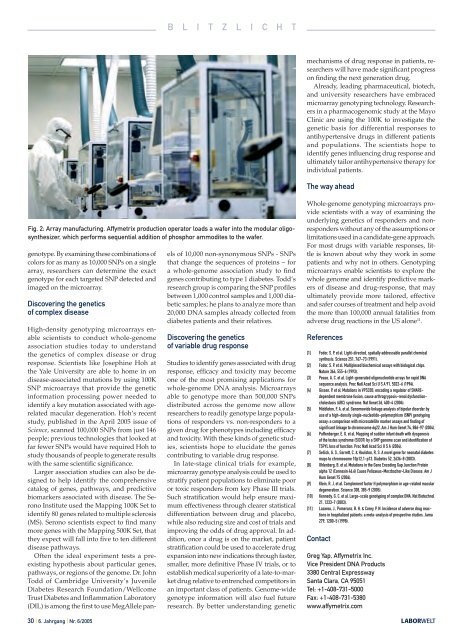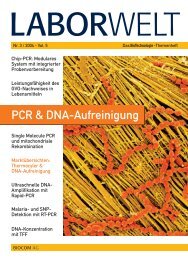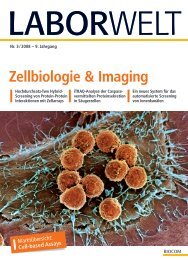PDF Download - Laborwelt
PDF Download - Laborwelt
PDF Download - Laborwelt
Sie wollen auch ein ePaper? Erhöhen Sie die Reichweite Ihrer Titel.
YUMPU macht aus Druck-PDFs automatisch weboptimierte ePaper, die Google liebt.
B L I T Z L I C H T<br />
Fig. 2: Array manufacturing. Affymetrix production operator loads a wafer into the modular oligosynthesizer,<br />
which performs sequential addition of phosphor ammodites to the wafer.<br />
genotype. By examining these combinations of<br />
colors for as many as 10,000 SNPs on a single<br />
array, researchers can determine the exact<br />
genotype for each targeted SNP detected and<br />
imaged on the microarray.<br />
Discovering the genetics<br />
of complex disease<br />
High-density genotyping microarrays enable<br />
scientists to conduct whole-genome<br />
association studies today to understand<br />
the genetics of complex disease or drug<br />
response. Scientists like Josephine Hoh at<br />
the Yale University are able to home in on<br />
disease-associated mutations by using 100K<br />
SNP microarrays that provide the genetic<br />
information processing power needed to<br />
identify a key mutation associated with agerelated<br />
macular degeneration. Hoh’s recent<br />
study, published in the April 2005 issue of<br />
Science, scanned 100,000 SNPs from just 146<br />
people; previous technologies that looked at<br />
far fewer SNPs would have required Hoh to<br />
study thousands of people to generate results<br />
with the same scientific significance.<br />
Larger association studies can also be designed<br />
to help identify the comprehensive<br />
catalog of genes, pathways, and predictive<br />
biomarkers associated with disease. The Serono<br />
Institute used the Mapping 100K Set to<br />
identify 80 genes related to multiple sclerosis<br />
(MS). Serono scientists expect to find many<br />
more genes with the Mapping 500K Set, that<br />
they expect will fall into five to ten different<br />
disease pathways.<br />
Often the ideal experiment tests a preexisting<br />
hypothesis about particular genes,<br />
pathways, or regions of the genome. Dr. John<br />
Todd of Cambridge University’s Juvenile<br />
Diabetes Research Foundation/Wellcome<br />
Trust Diabetes and Inflammation Laboratory<br />
(DIL) is among the first to use MegAllele pan-<br />
els of 10,000 non-synonymous SNPs - SNPs<br />
that change the sequences of proteins – for<br />
a whole-genome association study to find<br />
genes contributing to type 1 diabetes. Todd’s<br />
research group is comparing the SNP profiles<br />
between 1,000 control samples and 1,000 diabetic<br />
samples; he plans to analyze more than<br />
20,000 DNA samples already collected from<br />
diabetes patients and their relatives.<br />
Discovering the genetics<br />
of variable drug response<br />
Studies to identify genes associated with drug<br />
response, efficacy and toxicity may become<br />
one of the most promising applications for<br />
whole-genome DNA analysis. Microarrays<br />
able to genotype more than 500,000 SNPs<br />
distributed across the genome now allow<br />
researchers to readily genotype large populations<br />
of responders vs. non-responders to a<br />
given drug for phenotypes including efficacy<br />
and toxicity. With these kinds of genetic studies,<br />
scientists hope to elucidate the genes<br />
contributing to variable drug response.<br />
In late-stage clinical trials for example,<br />
microarray genotype analysis could be used to<br />
stratify patient populations to eliminate poor<br />
or toxic responders from key Phase III trials.<br />
Such stratification would help ensure maximum<br />
effectiveness through clearer statistical<br />
differentiation between drug and placebo,<br />
while also reducing size and cost of trials and<br />
improving the odds of drug approval. In addition,<br />
once a drug is on the market, patient<br />
stratification could be used to accelerate drug<br />
expansion into new indications through faster,<br />
smaller, more definitive Phase IV trials, or to<br />
establish medical superiority of a late-to-market<br />
drug relative to entrenched competitors in<br />
an important class of patients. Genome-wide<br />
genotype information will also fuel future<br />
research. By better understanding genetic<br />
mechanisms of drug response in patients, researchers<br />
will have made significant progress<br />
on finding the next generation drug.<br />
Already, leading pharmaceutical, biotech,<br />
and university researchers have embraced<br />
microarray genotyping technology. Researchers<br />
in a pharmacogenomic study at the Mayo<br />
Clinic are using the 100K to investigate the<br />
genetic basis for differential responses to<br />
antihypertensive drugs in different patients<br />
and populations. The scientists hope to<br />
identify genes influencing drug response and<br />
ultimately tailor antihypertensive therapy for<br />
individual patients.<br />
The way ahead<br />
Whole-genome genotyping microarrays provide<br />
scientists with a way of examining the<br />
underlying genetics of responders and nonresponders<br />
without any of the assumptions or<br />
limitations used in a candidate-gene approach.<br />
For most drugs with variable responses, little<br />
is known about why they work in some<br />
patients and why not in others. Genotyping<br />
microarrays enable scientists to explore the<br />
whole genome and identify predictive markers<br />
of disease and drug-response, that may<br />
ultimately provide more tailored, effective<br />
and safer courses of treatment and help avoid<br />
the more than 100,000 annual fatalities from<br />
adverse drug reactions in the US alone 11 .<br />
References<br />
[1] Fodor, S. P. et al. Light-directed, spatially addressable parallel chemical<br />
synthesis. Science 251, 767-73 (1991).<br />
[2] Fodor, S. P. et al. Multiplexed biochemical assays with biological chips.<br />
Nature 364, 555-6 (1993).<br />
[3] Pease, A. C. et al. Light-generated oligonucleotide arrays for rapid DNA<br />
sequence analysis. Proc Natl Acad Sci U S A 91, 5022-6 (1994).<br />
[4] Gissen, P. et al. Mutations in VPS33B, encoding a regulator of SNAREdependent<br />
membrane fusion, cause arthrogryposis-renal dysfunctioncholestasis<br />
(ARC) syndrome. Nat Genet 36, 400-4 (2004).<br />
[5] Middleton, F. A. et al. Genomewide linkage analysis of bipolar disorder by<br />
use of a high-density single-nucleotide-polymorphism (SNP) genotyping<br />
assay: a comparison with microsatellite marker assays and finding of<br />
significant linkage to chromosome 6q22. Am J Hum Genet 74, 886-97 (2004).<br />
[6] Puffenberger, E. G. et al. Mapping of sudden infant death with dysgenesis<br />
of the testes syndrome (SIDDT) by a SNP genome scan and identification of<br />
TSPYL loss of function. Proc Natl Acad Sci U S A (2004).<br />
[7] Sellick, G. S., Garrett, C. & Houlston, R. S. A novel gene for neonatal diabetes<br />
maps to chromosome 10p12.1-p13. Diabetes 52, 2636-8 (2003).<br />
[8] Uhlenberg, B. et al. Mutations in the Gene Encoding Gap Junction Protein<br />
alpha 12 (Connexin 46.6) Cause Pelizaeus-Merzbacher-Like Disease. Am J<br />
Hum Genet 75 (2004).<br />
[9] Klein, R. J. et al. Complement factor H polymorphism in age-related macular<br />
degeneration. Science 308, 385-9 (2005).<br />
[10] Kennedy, G. C. et al. Large-scale genotyping of complex DNA. Nat Biotechnol<br />
21, 1233-7 (2003).<br />
[11] Lazarou, J., Pomeranz, B. H. & Corey, P. N. Incidence of adverse drug reactions<br />
in hospitalized patients: a meta-analysis of prospective studies. Jama<br />
279, 1200-5 (1998).<br />
Contact<br />
Greg Yap, Affymetrix Inc.<br />
Vice President DNA Products<br />
3380 Central Expressway<br />
Santa Clara, CA 95051<br />
Tel: +1-408-731-5000<br />
Fax: +1-408-731-5380<br />
www.affymetrix.com<br />
30 | 6. Jahrgang | Nr. 6/2005 LABORWELT
















